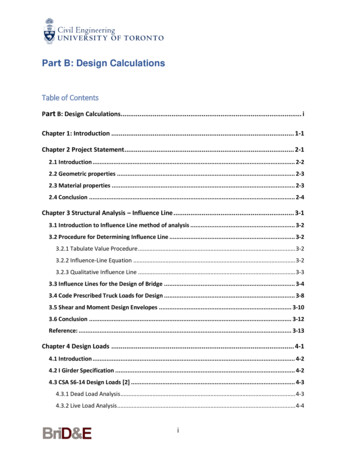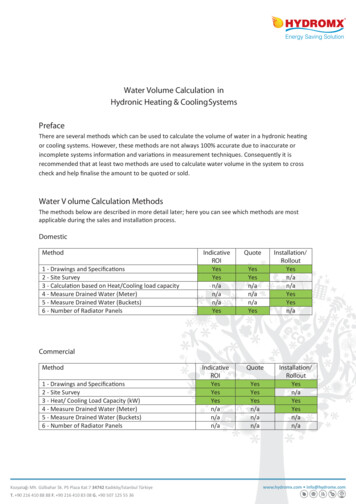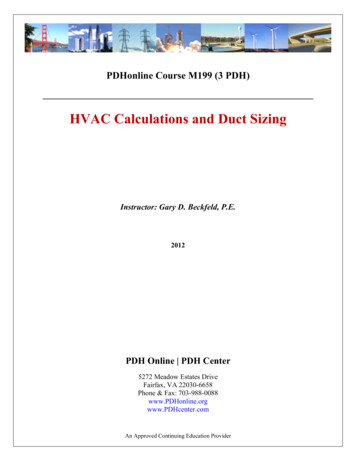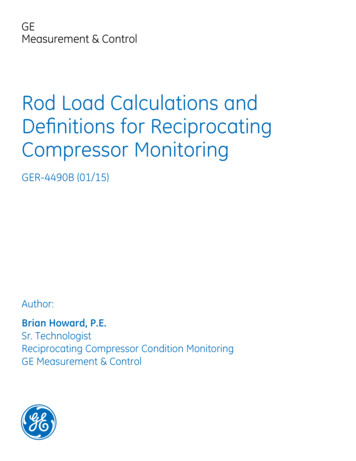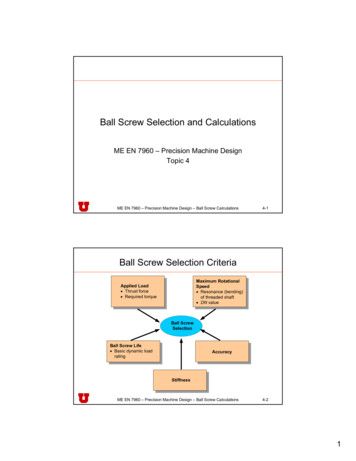
Transcription
Chapter 9 Electrical DesignAPPENDIX 9CDesign Calculations for Electrical DesignSPU Design Standards and GuidelinesNovember 2020i
Chapter 9 Electrical DesignAppendix 9C Design Calculations for Electrical DesignContents1.Introduction . 12.Software . 13.Calculation Matrix . 24.Basic Requirements for Electrical Calculations. 45.Basic Electrical Engineering Formulas . 45.1List of Symbols .45.2Direct Current (DC) Formulas .55.3Alternating Current (AC) Single Phase .55.4Alternating Current (AC), Three-Phase.55.5Motors .65.6Power Factor Correction .76.Sample Calculations . 76.1Load.76.2Generator Sizing.76.2.1Sizing Procedures for Generator Single or Multi-sets . 86.2.2Definitions: Generator Sizing . 86.2.3Underlying Equations . 86.3Conductor Size, General .106.4Conduit Size and Fill .136.5Motor Branch Circuit .146.6Power Factor Correction Capacitors.166.7Transformer Primary and Secondary Conductors .186.8Voltage Drop .206.8.1Feeder and Branch Circuits . 206.8.2Motor Starting . 216.9Short Circuit .226.10Lighting .246.11Grounding .296.12Cable Pulling Tension.296.13Equipment Heat Loads .30ii SPU Design Standards and GuidelinesNovember 2020
Chapter 9 Electrical DesignAppendix 9C Design Calculations for Electrical DesignList of TablesTable 9C-1 Calculations for Electrical Design . 2Table 9C-2 NEC References for Conductor Sizing . 10Table 9C-3 Total conductor area . 14Table 9C-4 General Electric’s Recommendations . 15Table 9C-5 Coefficient of Utilization Zonal Cavity Method . 25Table 9C-6 Candlepower Distribution Curve. 27Table 9C-7 Losses in Electrical Equipment . 30List of ExamplesExample 9C-1 Motors. 6Example 9C-2 Conductor Size No. 1 . 11Example 9C-3 Conductor Size No. 2 . 12Example 9C-4 Conductor Size No. 3 . 12Example 9C-5 Conductor Size No. 3 . 13Example 9C-6 Conduit Size and Fill No. 1 . 13Example 9C-7 Conduit Size and Fill No. 2 . 14Example 9C-8 Motor Branch Circuit No. 1. 15Example 9C-9 Motor Branch Circuit No. 2. 16Example 9C-10 Power Factor No. 1 . 17Example 9C-11 Power Factor Correction Capacitor No. 2 . 18Example 9C-12 Transformer Primary and Secondary Conductors No. 1 . 18Example 9C-13 Transformer Primary and Secondary Conductors No. 2 . 19Example 9C-14 Transformer Primary and Secondary Conductors No. 3 . 20Example 9C-15 Feeder and Branch Circuits . 21Example 9C-16 Short Circuit . 22Example 9C-17 Lighting No 1: Lumen or Zonal Cavity Method . 24Example 9C-18 Lighting No 2: Point by Point Calculation . 27SPU Design Standards and GuidelinesNovember 2020iii
Chapter 9 Electrical DesignAppendix 9C Design Calculations for Electrical Design1.INTRODUCTIONThis appendix presents standards and guidelines for electrical design calculations for SPUprojects.Design calculations establish minimum guidelines and requirements for generating electricalcalculations on projects. Electrical calculations should be made for all SPU projects that includeelectrical components and should be filed in the project notebook. Design calculations may bemade either manually or by SPU-approved computer programs. At a minimum, the followingtypes of calculations should be made where applicable: Load calculations Conductor sizing Conduit sizing Motor branch circuit sizing Power factor improvement Transformer primary and secondary circuit sizing Voltage drop Motor starting voltage dip Short circuit analysis Lighting levels Grounding in substations where step potentials are of concern Harmonic distortion analysis Cable pulling calculations Generator capability/motor starting2.SOFTWAREThe electrical design engineer must use only SPU-approved electrical analysis software. Theresults should be validated with a hand calculation or order of magnitude estimate. Some SPUapproved software tools are: SKM Power Tools for Windows (PTW) software. It includes a basic tool, DAPPER (loadcurrent, voltage drop, conductor sizing, etc) and several specialized tools such asHI WAVE (harmonic analysis) and CAPTOR (circuit breaker coordination and settings) Cummins Power Suite for sizing emergency generators CenterONE available from Rockwell Automation for laying out motor control centersSpreadsheets may also be used to perform basic electrical load calculations with programs suchas Microsoft EXCEL.SPU Design Standards and GuidelinesNovember 20201
Chapter 9 Electrical DesignAppendix 9C Design Calculations for Electrical Design3.CALCULATION MATRIXProject calculations serve as formal documentation of the project electrical design. They mustcontain sufficient description and detail to communicate the design concept, assumptions, andjudgments associated with the design. Explanatory comments should be provided to assistreviewers and engineers who may use the calculations in the future.Table 9C-1 describes electrical calculation required for projects, tools to do the calculations, whois responsible for the calculations, and when they should be done.Table 9C-1Calculations for Electrical Phase (%)30/ 60/90CalculationLoad facility,switchgear,MCCDescriptionLoad at each load center perNEC to determine bus,protective device & circuitsizeRequired Tools1SKM PTWDAPPER,Spreadsheets,hand calcsLoad panelboardLoad on each panelboard perNEC to determine panel,circuit, and transformer sizeSKM PTWDAPPER,spreadsheetsXX60 and 90GeneratorsizingTo size engine generatorbased on critical run andstart loads.Cat, Kohler,Cummins, orother vendorsoftwareXX30/ 60/90Short CircuitAvailable fault current at eachbus to determine equipmentshort circuit/interruptingratingsSKM PTWDAPPER,Hand CalculationXXLightingTo determine fixturesneeded given desired lightlevel; also energy calculations(where req’d)AGI 32, Vendor,spreadsheetsXX60 and 90ConductorsizingTo size conductors per NECTables, hand calcsXX60 and 90Circuitbreaker andfuse sizingTo size circuit breakers andfuses per NECTables, hand calcsXX60 and 90ConduitFill/Tray SizeTo size conduit and cabletray per NECNEC Tables,Cablematic PlusXX60 and 90Voltage dropFor heavily loaded and/orlong circuits to confirmoperation within NECrecommendations (min)SKM PTWDAPPER,spreadsheets,hand calcsXX60 and 90TransientMotorStartingFor starting large motors(largest motor at each loadcenter) to determine ifvoltage drop on motorstarting is magnitude toadversely impact othersystem equipment (e.g. 20%voltage dip could makecontrol relays drop out. ManySKM PTW TMS,hand calcsX2 SPU Design Standards and GuidelinesX30/60/90November 2020
Chapter 9 Electrical DesignAppendix 9C Design Calculations for Electrical DesignByEngr3ByCntr3DesignPhase (%)XXX30/60/90NEC Tables,Cablematic PlusXX60 and 90For higher than "normal"ambient temperatures--couldinclude heat from multiplecircuits in duct bankAMP CALC, NECtablesXX60 and 90ProtectivedevicecoordinationTo minimize outages tosmallest portion of systempossibleSKM PTWCAPTORXXX90Cable PullingTo assure no damage to cablewhen pulled in conduit givenconduit size, distance andbends. Rq’d for mediumvoltage & some large/longlow-voltagePolywater or othervendor softwareXXX60, 90 dsgncheck;by cntrctrin ConstrbeforepullingArc-flashTo label gear regarding arcflash hazard and PPErequired. NEC requires label,not calcs. Reference NFPA70E and IEEE 1584.SKM PTW ArcFlash EvaluationXX90Power factorcorrectionTo size capacitors for singlemotor or systems.XXBattery/UPSsizingTo determine amp-hourbased on load and duration.XXX90, ConstrTransformerK-factorTo determine appropriate Kfactor for transformers withnon-linear loadsXXX90, ConstrVFDreflectivewaveFor motor distant from VFDXXX90, ConstrLightningProtectionStrikeDistanceMay be performance specifiedXXX60 and 90CalculationDescriptionare only designed to operate15% below rated voltage.)Required Tools1HarmonicDistortionAnalysisTo confirm operation withinIEEE 519 requirements (min)for non-linear loadsSKM PTWHI WAVE, GE orother vendorsoftwareMultiplecircuitderatingFor more than 3 currentcarrying conductors in aconduit per NECAmbienttemperaturecircuitderatingper NFPA 780Req’dAllReq’dCond260 and 90Notes1 Suggested tools for use in SPU projects.2 Responsible party. Contractor-provided calculations may require design engineer-provided criteria.3 Required conditionally: Required when applicableSPU Design Standards and GuidelinesNovember 20203
Chapter 9 Electrical DesignAppendix 9C Design Calculations for Electrical Design4.BASIC REQUIREMENTS FORELECTRICAL CALCULATIONSThe following are SPU basic requirements for electrical calculations:1. Non-computer generated calculations must be on
ELECTRICAL CALCULATIONS The following are SPU basic requirements for electrical calculations: 1. Non-computer generated calculations must be on standard calculations sheets with the heading completely filled out. 2. Calculations generated by computer programs must conform with the following procedures: a. Include all heading information on each sheetFile Size: 457KBPage Count: 34

